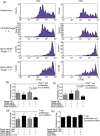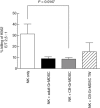Neutrophilic myeloid-derived suppressor cells in cord blood modulate innate and adaptive immune responses
- PMID: 23701226
- PMCID: PMC3784212
- DOI: 10.1111/cei.12143
Neutrophilic myeloid-derived suppressor cells in cord blood modulate innate and adaptive immune responses
Abstract
Neonates show an impaired anti-microbial host defence, but the underlying immune mechanisms are not understood fully. Myeloid-derived suppressor cells (MDSCs) represent an innate immune cell subset characterized by their capacity to suppress T cell immunity. In this study we demonstrate that a distinct MDSC subset with a neutrophilic/granulocytic phenotype (Gr-MDSCs) is highly increased in cord blood compared to peripheral blood of children and adults. Functionally, cord blood isolated Gr-MDSCs suppressed T cell proliferation efficiently as well as T helper type 1 (Th1), Th2 and Th17 cytokine secretion. Beyond T cells, cord blood Gr-MDSCs controlled natural killer (NK) cell cytotoxicity in a cell contact-dependent manner. These studies establish neutrophilic Gr-MDSCs as a novel immunosuppressive cell subset that controls innate (NK) and adaptive (T cell) immune responses in neonates. Increased MDSC activity in cord blood might serve as key fetomaternal immunosuppressive mechanism impairing neonatal host defence. Gr-MDSCs in cord blood might therefore represent a therapeutic target in neonatal infections.
Keywords: Gr-MDSC; MDSC; NK cells; Th17; cord blood; myeloid-derived suppressor cells; neonatal; neutrophilic.
© 2013 British Society for Immunology.
Figures




References
-
- Levy O. Innate immunity of the newborn: basic mechanisms and clinical correlates. Nat Rev Immunol. 2007;7:379–390. - PubMed
-
- Adkins B, Leclerc C, Marshall-Clarke S. Neonatal adaptive immunity comes of age. Nat Rev Immunol. 2004;4:553–564. - PubMed
-
- Gille C, Spring B, Tewes LJ, et al. Diminished response to interleukin-10 and reduced antibody-dependent cellular cytotoxicity of cord blood monocyte-derived macrophages. Pediatr Res. 2006;60:152–157. - PubMed
-
- Marodi L. Innate cellular immune responses in newborns. Clin Immunol. 2006;118:137–144. - PubMed
Publication types
MeSH terms
LinkOut - more resources
Full Text Sources
Other Literature Sources

